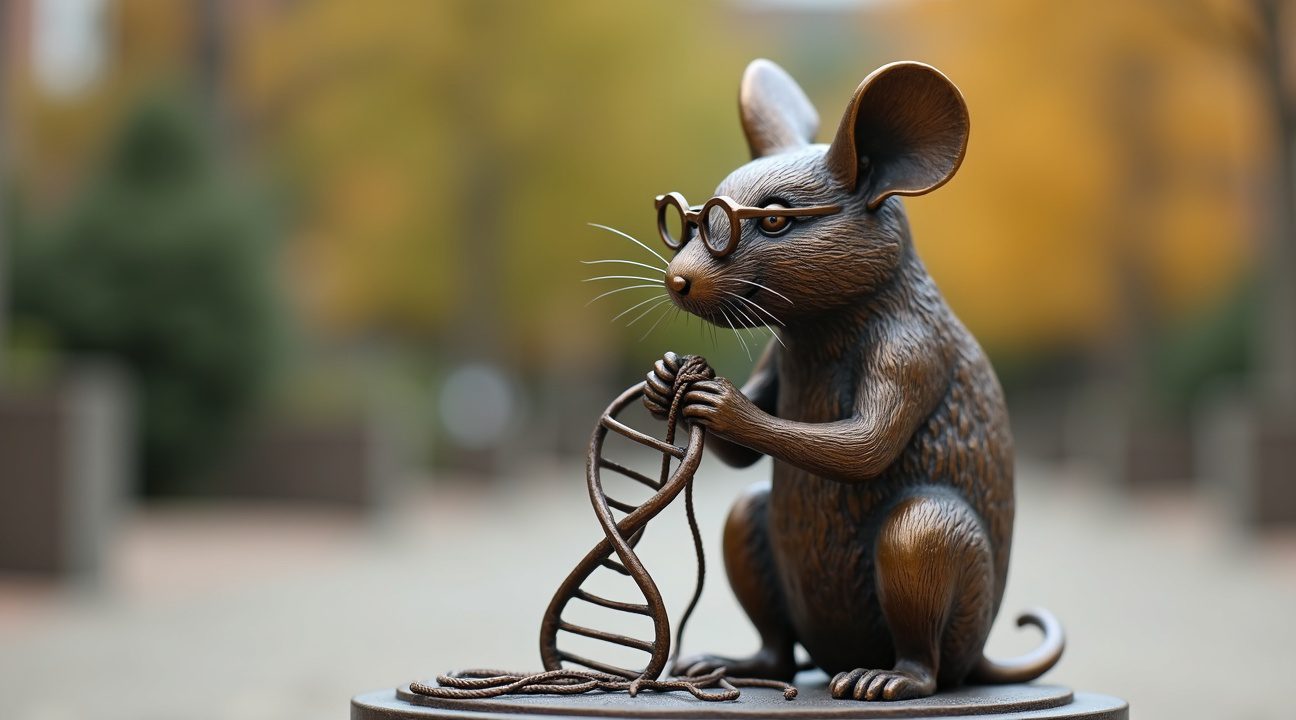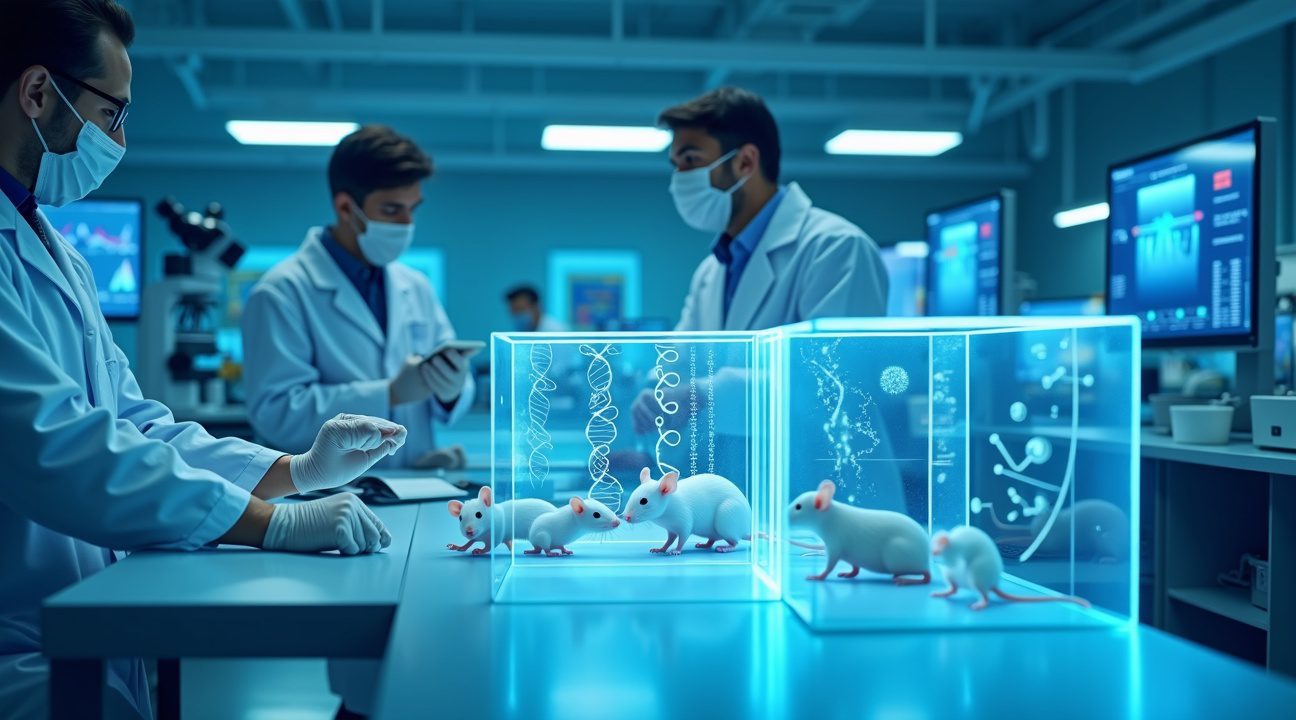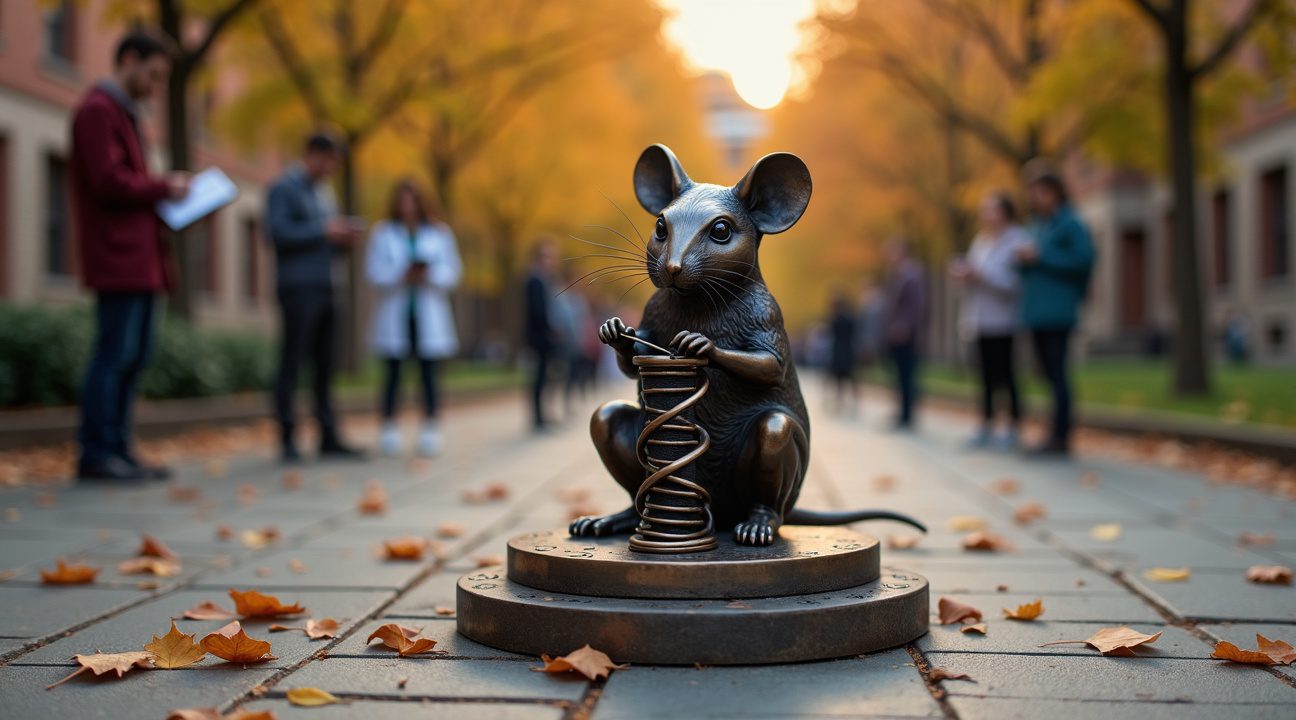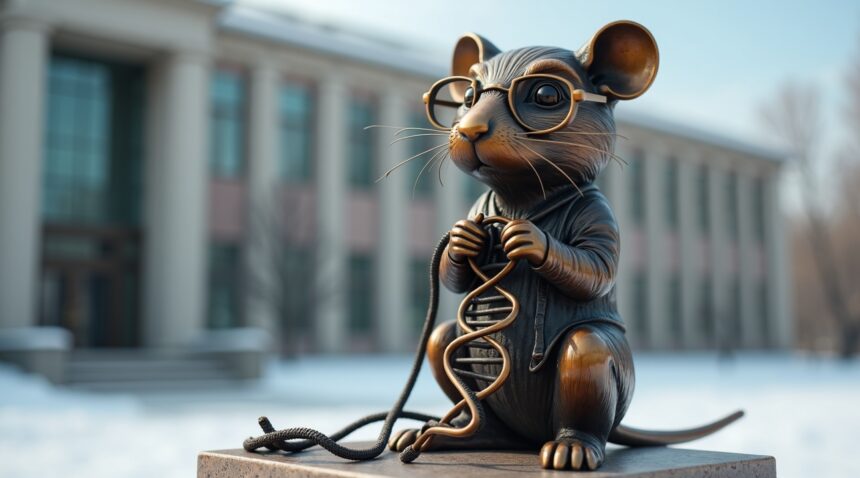A bronze monument in Novosibirsk, Russia, features an anthropomorphic mouse wearing glasses while knitting a DNA double helix, creating a powerful tribute to countless laboratory mice that have contributed to scientific breakthroughs.
Key Takeaways
- The monument depicts a mouse wearing glasses and knitting a DNA double helix, symbolizing the careful construction of scientific knowledge through systematic experimentation.
- Created through collaboration between artist Andrei Kharkevich, sculptor Alexei Agrikolyansky, and bronze caster Maxim Petrov, the memorial stands at the Institute of Cytology and Genetics in Novosibirsk.
- Laboratory mice share approximately 95% of human genes, making them invaluable for understanding diseases and testing treatments that have led to breakthroughs in cancer therapy, diabetes treatment, and vaccine development.
- The monument sparks complex emotional reactions from visitors, who often feel both gratitude for medical advances and contemplation about the ethical implications of animal testing.
- The Institute of Cytology and Genetics, established in 1957, continues to conduct cutting-edge research in genetics while maintaining the memorial as a reminder of responsible scientific practices.
Russia’s Bronze Mouse Knits DNA to Honor Science’s Unsung Heroes
The remarkable bronze sculpture features an anthropomorphic mouse engaged in the intricate act of knitting a DNA double helix using delicate knitting needles. Artist Andrei Kharkevich conceived this powerful design to capture the essence of scientific discovery, while sculptor Alexei Agrikolyansky brought the vision to life with exceptional craftsmanship. Maxim Petrov completed the artistic collaboration by casting the final bronze piece that now stands as a testament to scientific progress.
This unique statue presents the mouse character wearing small glasses, adding an intellectual quality that bridges the gap between laboratory animal and researcher. The creature’s focused expression while manipulating the knitting needles creates a compelling visual metaphor for the careful, methodical work that defines scientific research. DNA strands emerge from the needles in perfect double helix formation, symbolizing the genetic discoveries that countless lab mice have made possible through their participation in research studies.
Symbolic Design Elements
The artistic choices in this monument reflect deep consideration for the relationship between scientific collaboration and sacrifice. The knitting metaphor proves particularly powerful because it represents the careful construction of knowledge, strand by strand, much like how researchers build understanding through systematic experimentation. Each stitch in the DNA helix represents discoveries that have led to medical breakthroughs, from cancer treatments to genetic therapies.
The glasses worn by the bronze mouse serve multiple symbolic purposes, suggesting both the intelligence required for scientific work and the careful observation that characterizes quality research. This design choice elevates the laboratory mouse from mere test subject to collaborative partner in the pursuit of knowledge. The mouse’s posture conveys concentration and purpose, emphasizing that scientific progress requires dedication from both researchers and their animal subjects.
Artistic Collaboration Behind the Monument
Kharkevich’s original concept required careful translation into three-dimensional form, a challenge that Agrikolyansky met with remarkable skill. The sculptor had to balance anatomical accuracy with the whimsical elements that make the piece accessible to general audiences. Creating believable knitting needles at the appropriate scale while maintaining the integrity of the DNA structure demanded significant technical expertise.
Petrov’s bronze casting work preserved every detail of the sculpture, ensuring that the delicate knitting needles and complex DNA helix would endure for generations. The patina chosen for the bronze gives the piece a warm, approachable quality that invites viewers to examine the intricate details up close. This attention to finish work transforms what could have been a purely academic monument into an engaging piece of public art.
The collaborative nature of this project mirrors the scientific collaboration it commemorates. Just as researchers work together with laboratory animals to advance human knowledge, the three artists combined their unique skills to create something greater than any individual contribution.
- Kharkevich provided the conceptual foundation.
- Agrikolyansky translated vision into form.
- Petrov ensured permanent preservation through expert bronze work.
Modern scientific ethics increasingly recognize the important contributions that laboratory animals make to human health and knowledge. This monument acknowledges that relationship while celebrating the discoveries that have emerged from careful research protocols. The DNA double helix being knitted by the mouse represents everything from basic genetic understanding to breakthrough treatments for previously incurable diseases.
The statue’s placement in Russia reflects that nation’s significant contributions to biological and medical research. Russian scientists have made crucial discoveries in genetics, neuroscience, and cellular biology, often working with mouse models that have proven essential for understanding human health conditions. These genetic discoveries continue to shape medical practice worldwide.
Visitors often pause to photograph the intricate details of this bronze tribute, particularly the precisely rendered DNA structure emerging from the knitting needles. Children find the mouse character engaging and approachable, while adults appreciate the deeper symbolism embedded in the artistic design. The monument succeeds in making complex scientific concepts accessible through visual metaphor, creating connections between public understanding and research laboratory realities.
This bronze mouse stands as recognition that scientific progress depends on contributions from many sources, acknowledging the sacrifice made by countless laboratory animals while celebrating the knowledge their participation has generated.

Novosibirsk Monument Marks 120 Years of Scientific Achievement
I find it remarkable that one of the most touching tributes to scientific progress stands in the heart of Siberia. The Monument to the Laboratory Mouse was unveiled on July 1, 2013, in Novosibirsk, Russia, marking a dual celebration of the city’s 120th anniversary and the 55th anniversary of the Institute of Cytology and Genetics.
This unique memorial sits prominently in front of the Institute of Cytology and Genetics, which belongs to the prestigious Russian Academy of Sciences. The timing of the monument’s dedication wasn’t coincidental – it honored both the city’s rich history and the scientific institution that has shaped genetic research for over half a century.
The Institute of Cytology and Genetics began its groundbreaking work in 1957, focusing on genetic studies that would later influence DNA research across the globe. Since its establishment, this facility has played a crucial role in advancing our understanding of heredity, cellular biology, and molecular genetics. Laboratory mice have been central to these discoveries, serving as vital subjects in countless experiments that have led to medical breakthroughs.
Scientific Legacy in Bronze
The monument itself captures the essence of scientific sacrifice and discovery. I appreciate how the creators chose to honor these small creatures that have contributed immeasurably to human knowledge. Laboratory mice have been instrumental in developing treatments for cancer, understanding genetic disorders, and testing new medications before they reach human trials.
The research conducted at this Novosibirsk institute has contributed to several key areas of genetic studies. Scientists there have worked on projects ranging from basic cellular mechanisms to complex genetic engineering techniques. Their work with laboratory mice has helped unlock secrets of aging, disease resistance, and hereditary conditions that affect millions of people worldwide.
What makes this monument particularly significant is its location in Siberia, far from the typical centers of scientific recognition. Novosibirsk has emerged as a major hub for genetic research, and the institute’s work continues to influence scientific communities internationally. The city’s commitment to honoring scientific achievement through this monument demonstrates Russia’s dedication to recognizing the contributions of both researchers and their animal subjects.
The monument serves multiple purposes beyond commemoration. It raises public awareness about the role of animal testing in medical advancement, much like how DNA research has captured public imagination in recent years. Visitors to the institute can see firsthand how scientific progress often depends on the careful study of model organisms.
Laboratory mice remain essential to modern genetic studies because they share approximately 95% of human genes. This genetic similarity makes them invaluable for understanding how diseases develop and how treatments might work in humans. The Institute of Cytology and Genetics has used this knowledge to advance research in areas including neuroscience, immunology, and developmental biology.
The 2013 unveiling ceremony attracted scientists, city officials, and curious residents who gathered to witness this unusual dedication. Unlike traditional monuments that honor human achievements, this tribute acknowledges the often-overlooked contributions of laboratory animals to scientific progress. The monument stands as a reminder that major medical breakthroughs rarely happen without extensive preliminary research using animal models.
DNA research at the institute has expanded significantly since 1957, incorporating new technologies and methodologies that weren’t available during the facility’s early years. Modern genetic studies now include:
- Genome sequencing
- Gene editing techniques
- Precision medicine approaches
All of these advancements rely heavily on initial testing in laboratory mice.
The Monument to the Laboratory Mouse represents more than just local recognition – it symbolizes a global acknowledgment of the ethical responsibilities researchers bear when conducting animal experiments. Scientific institutions worldwide have increasingly emphasized the importance of treating research animals with respect and minimizing their suffering while maximizing the knowledge gained from their sacrifice.
This Siberian monument continues to inspire discussions about the balance between scientific advancement and animal welfare, ensuring that future generations of researchers remember the debt science owes to these small but significant contributors to human knowledge.
Why Laboratory Mice Are Essential to Medical Breakthroughs
Laboratory mice serve as the backbone of modern medical research, contributing to virtually every major breakthrough in disease treatment and drug development. Their genetic makeup shares approximately 95% similarity with humans, making them invaluable models for understanding how diseases progress and how potential treatments might work in human patients.
The Scientific Advantages of Mouse Models
Researchers choose mice for several practical and scientific reasons that make them perfect research subjects. Their short lifespan of two to three years allows scientists to observe entire disease progressions and treatment effects within manageable timeframes. Quick breeding cycles enable researchers to study genetic variations across multiple generations, providing insights into hereditary conditions that might take decades to observe in humans.
Mice also possess immune systems and organ functions remarkably similar to humans, making them ideal for testing new medications and vaccines. DNA research has shown that many mouse genes have direct human counterparts, allowing scientists to create genetically modified mice that develop specific human diseases like cancer, diabetes, and Alzheimer’s.
Contributions to Life-Saving Treatments
The sacrifices made by laboratory mice have directly led to treatments that save millions of human lives annually. Insulin therapy for diabetes, chemotherapy protocols for cancer, and vaccines for polio all relied heavily on mouse studies during their development phases. Modern COVID-19 vaccines underwent extensive testing in mouse models before human trials, accelerating the timeline for safe and effective treatments.
Without these small creatures, many surgical techniques, organ transplant procedures, and genetic therapies would remain theoretical concepts rather than practical medical interventions. I recognize that technological advances continue to improve research methods, but mice remain irreplaceable for understanding complex biological interactions.
Animal testing ethics require researchers to follow strict protocols ensuring humane treatment and minimizing suffering. The “3 Rs” principle guides this work:
- Replace animal models when possible
- Reduce the number of animals used
- Refine procedures to minimize distress
Scientists understand their responsibility to honor these creatures’ contributions by conducting meaningful research that directly benefits human health.
Biomedical research facilities worldwide maintain rigorous standards for animal care, with veterinary oversight and ethical review boards evaluating each study’s necessity and design. Future innovations may eventually reduce reliance on animal models, but current alternatives like computer simulations and cell cultures can’t replicate the complex interactions found in living organisms.

The Ethical Debate Behind Animal Testing
I find myself confronting one of science’s most contentious issues when examining the monument dedicated to laboratory mice. The statue stands as a rare acknowledgment that forces society to reckon with the moral implications of animal experimentation. Organizations like PETA continue to challenge the ethics of using animals for research purposes, arguing that sentient beings shouldn’t bear the burden of human scientific advancement.
The bronze figures represent millions of creatures that have contributed to medical breakthroughs throughout history. Their sacrifices have led to treatments for cancer, diabetes, and countless other conditions that save human lives daily. Yet this progress comes at a cost that many consider unacceptable in modern society.
Balancing Scientific Progress with Animal Welfare
The monument creates space for reflection on humanity’s complex relationship with laboratory animals. Scientists argue that animal testing remains essential for developing safe medicines and treatments. They point to strict regulations and oversight committees that ensure experiments minimize suffering while maximizing scientific value. Alternative methods like computer modeling and cell cultures continue to evolve, though they can’t fully replace animal models for complex biological systems.
Critics maintain that animals possess inherent rights that supersede human scientific interests. They advocate for complete elimination of animal testing, pushing for increased funding in alternative research methods. The debate intensifies when considering that many breakthroughs in fields ranging from genetic research to medical treatments have relied heavily on animal studies.
The Russian monument serves as an unusual bridge between these opposing viewpoints. Rather than ignoring the ethical dilemma, it acknowledges the contributions while honoring the lives lost. This approach recognizes that scientific progress often requires difficult choices that affect other species.
Modern biomedical research increasingly emphasizes the “3 Rs” principle:
- Replace animal testing with alternatives whenever possible
- Reduce the number of animals used in studies
- Refine procedures to minimize distress
This framework attempts to balance scientific necessity with ethical responsibility.
The statue’s presence in an academic setting reinforces the importance of maintaining ethical standards in research. It reminds future scientists that their work affects living beings and that progress shouldn’t come without careful consideration of its impact. The monument challenges researchers to pursue knowledge while respecting the creatures that make their discoveries possible.
This ongoing ethical discussion reflects broader questions about humanity’s relationship with animals and the responsibilities that come with scientific advancement. The memorial ensures that these vital conversations continue as research methods evolve and society’s understanding of animal consciousness deepens.

How Visitors React to This Unique Scientific Memorial
The reactions to Russia’s laboratory mouse monument reveal fascinating insights into public perception of scientific ethics and animal welfare. Visitors consistently describe their experience as emotionally complex, finding themselves caught between admiration for scientific progress and sorrow for the countless animals that made it possible.
Most people express genuine surprise at encountering such a memorial. The monument challenges typical expectations of what deserves commemoration, prompting deeper reflection on the hidden costs of medical advancement. Many visitors report feeling a mix of gratitude and guilt — grateful for life-saving treatments that resulted from animal testing, yet uncomfortable with the reality of what those advances required.
Art enthusiasts frequently praise the memorial’s aesthetic qualities and symbolic power. The detailed craftsmanship captures both the vulnerability of laboratory animals and their unwitting heroism. Some observers compare it to other unconventional monuments that honor overlooked contributors to human progress, noting how it elevates typically invisible participants in scientific research.
Emotional and Ethical Responses
The cultural impact extends beyond simple appreciation, sparking meaningful conversations about scientific ethics among diverse visitor groups. Parents often use the monument as a teaching moment, explaining to children how medical breakthroughs require difficult choices and sacrifices. These discussions highlight the memorial’s educational value in making abstract ethical concepts tangible and accessible.
International visitors frequently comment on the monument’s uniqueness, noting they’ve never encountered anything similar in their home countries. This reaction underscores how scientific progress often remains disconnected from public consciousness regarding its methods and costs. The memorial bridges this gap by creating a physical space for contemplation.
Scientists and researchers who visit often express particular appreciation for the acknowledgment of their work’s complexities. Many describe feeling validated that someone recognized the ethical weight they carry in their professional lives. Laboratory workers report that the monument helps them process their own feelings about animal testing, providing a rare opportunity to publicly honor the subjects of their research.
Students studying biology, medicine, and related fields find the memorial especially impactful. Many describe it as a turning point in understanding their future profession’s responsibilities. The monument transforms abstract discussions about research ethics into concrete emotional experiences that many carry forward in their careers.
The memorial also attracts critics who view it as insufficient gesture compared to reducing animal testing altogether. These visitors appreciate the acknowledgment but argue that honoring sacrifices shouldn’t substitute for developing alternative research methods. Their perspective adds another layer to the ongoing dialogue about scientific innovation and ethical responsibility.
Local residents have gradually embraced the monument as a source of community pride, despite initial confusion about its purpose. The memorial has become a landmark that distinguishes their city as a place that thinks deeply about scientific progress and its implications. Tour guides report that international visitors specifically seek out the monument, contributing to local tourism.
Photography at the site reveals interesting patterns in how people interact with the memorial. Many visitors approach solemnly, reading the inscription carefully before observing moments of silence. Others take selfies, though typically with more subdued expressions than usual tourist photos. These behavioral patterns suggest the monument successfully creates a contemplative atmosphere that influences visitor conduct.
Social media posts about the memorial often include lengthy captions reflecting on animal welfare and scientific ethics. Users frequently share personal stories about pets, medical treatments that saved family members, or career choices influenced by encountering the monument. This digital conversation extends the memorial’s impact far beyond its physical location.
The monument’s influence on public perception demonstrates how art can make complex ethical issues accessible to general audiences. By honoring laboratory animals, it creates space for nuanced discussions about progress, sacrifice, and responsibility that might otherwise remain confined to academic or professional circles. Visitors consistently report leaving with new appreciation for both scientific advancement and the creatures that made it possible.
The Institute of Cytology and Genetics: A Hub for Genetic Research
The Institute of Cytology and Genetics stands as one of Russia’s premier scientific institutions, operating under the prestigious Russian Academy of Sciences since its establishment in 1957. I find it remarkable how this facility has dedicated over six decades to advancing our understanding of genetics and cellular biology. The institute’s founders recognized the critical importance of genetic research during an era when DNA’s structure had only recently been discovered.
Pioneering Scientific Excellence
This research powerhouse has consistently pushed the boundaries of genetic science, conducting groundbreaking studies that have contributed to global scientific knowledge. The institute’s researchers have made significant contributions to our understanding of gene regulation, chromosome structure, and hereditary mechanisms. Their work spans multiple disciplines, from basic cellular research to applied genetics that benefits agriculture and medicine.
Scientists at the facility have published thousands of research papers and collaborated with international institutions to advance genetic research. The institute’s laboratories house state-of-the-art equipment and maintain extensive collections of genetic material from various species. This comprehensive approach allows researchers to conduct comparative studies that reveal fundamental principles of life.
A Living Memorial to Scientific Sacrifice
The mouse monument at the institute serves a deeper purpose than simple decoration—it represents the facility’s ethical commitment to honoring every contributor to scientific progress. Laboratory mice have played an indispensable role in genetic discoveries that have saved countless human lives. The statue acknowledges that scientific advancement often requires difficult choices and sacrifices.
Researchers at the institute understand that their work builds upon the contributions of millions of laboratory animals. The monument creates a space for reflection and gratitude, reminding scientists and visitors alike of the responsibility that comes with conducting genetic research. This acknowledgment reflects the institute’s broader philosophy about responsible science and ethical research practices.
The Institute of Cytology and Genetics continues to lead Russian scientific efforts in genetics while maintaining its commitment to honoring all participants in the scientific process. The facility’s reputation extends far beyond Russia’s borders, attracting international collaborators and researchers who contribute to its ongoing mission. Much like how technological innovations reshape industries, the institute’s work has fundamentally changed how we understand life itself.
Modern genetic research at the institute focuses on several key areas, including:
- Cancer genetics
- Developmental biology
- Agricultural genetics
Scientists there work to develop new treatments for genetic diseases while also improving crop yields through genetic modification. The breadth of research conducted at the facility demonstrates how genetic science can address challenges ranging from human health to food security.
The institute’s commitment to transparency and ethical research practices sets it apart in the scientific community. Researchers there regularly engage with the public through educational programs and open houses, sharing their discoveries and explaining the importance of genetic research. This approach helps build public trust and understanding of scientific work.
Laboratory animals continue to play essential roles in the institute’s research programs, and scientists there maintain the highest standards of animal care and welfare. The mouse monument serves as a daily reminder of the responsibility researchers bear when working with living subjects. This constant acknowledgment of sacrifice helps ensure that research is conducted with appropriate gravity and respect.
The Institute of Cytology and Genetics has evolved from a modest research facility into a world-renowned center for genetic science. Its researchers have contributed to breakthrough discoveries in:
- Gene therapy
- Genetic engineering
- Disease prevention
The facility’s work has practical applications that benefit millions of people worldwide, from improved medical treatments to enhanced agricultural productivity.
The monument stands as a testament to the institute’s values and its recognition that scientific progress requires contributions from many sources. This unique approach to honoring research subjects reflects the facility’s commitment to ethical science and responsible research practices that benefit humanity while respecting all participants in the scientific process.
Sources:
Russian Academy of Sciences – “The Institute of Cytology and Genetics: A Hub for Genetic Research”
PETA – “The Ethical Debate Behind Animal Testing”


